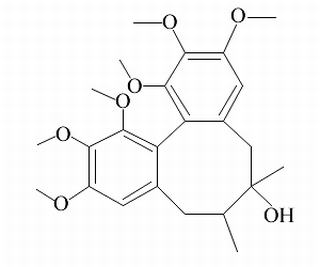Home
Products
Schisandrol A



| Product Name | Schisandrol A |
| Price: | $25 / 20mg |
| Catalog No.: | CN03007 |
| CAS No.: | 7432-28-2 |
| Molecular Formula: | C24H32O7 |
| Molecular Weight: | 432.5 g/mol |
| Purity: | >=98% |
| Type of Compound: | Lignans |
| Physical Desc.: | Powder |
| Source: | The fruits of Schisandra chinensis (Turcz.) Baill. |
| Solvent: | Chloroform, Dichloromethane, Ethyl Acetate, DMSO, Acetone, etc. |
| SMILES: | COc1c(OC)cc2c(c1OC)c1c(cc(c(c1OC)OC)OC)C[C@@H]([C@@](C2)(C)O)C |
| Contact us | |
|---|---|
| First Name: | |
| Last Name: | |
| E-mail: | |
| Question: | |
| Description | Schisandrin has various therapeutic effects on a range of medical conditions such as anti-asthmatic, anti-cancer, and anti-inflammatory effects.IC50 value:Target:in vitro: Sch inhibited the pro-fibrotic activity of TGF-β1 in AML12 cells; thus, it suppressed the accumulation of ECM proteins. Also, Sch inhibited the EMT as assessed by reduced expression of vimentin and fibronectin, and increased E-cadherin and ZO-1 in TGF-β1 induced AML12 cells. Sch reduced TGF-β1-mediated phosphorylation of Smad2/3 and Smad3/4 DNA binding activity. On the other hand, Sch reduced TGF-β1-induced ERK1/2 and PI3K/Akt phosphorylation in the non-Smad pathway [1]. the anti-inflammatory properties of schisandrin result from the inhibition of nitric oxide (NO) production, prostaglandin E(2) (PGE(2)) release, cyclooxygenase-2 (COX-2) and inducible nitric oxide synthase (iNOS) expression, which in turn results from the inhibition of nuclear factor-kappaB (NF-kappaB), c-Jun N-terminal kinase (JNK) and p38 mitogen-activated protein kinase (MAPK) activities in a RAW 264.7 macrophage cell line [2]. |
| Density | 1.1±0.1 g/cm3 |
| Boiling Point | 576.7±50.0 °C at 760 mmHg |
| Flash Point | 302.6±30.1 °C |
| Exact Mass | 432.214813 |
| PSA | 75.61000 |
| LogP | 4.18 |
| Vapour Pressure | 0.0±1.7 mmHg at 25°C |
| Storage condition | room temp |